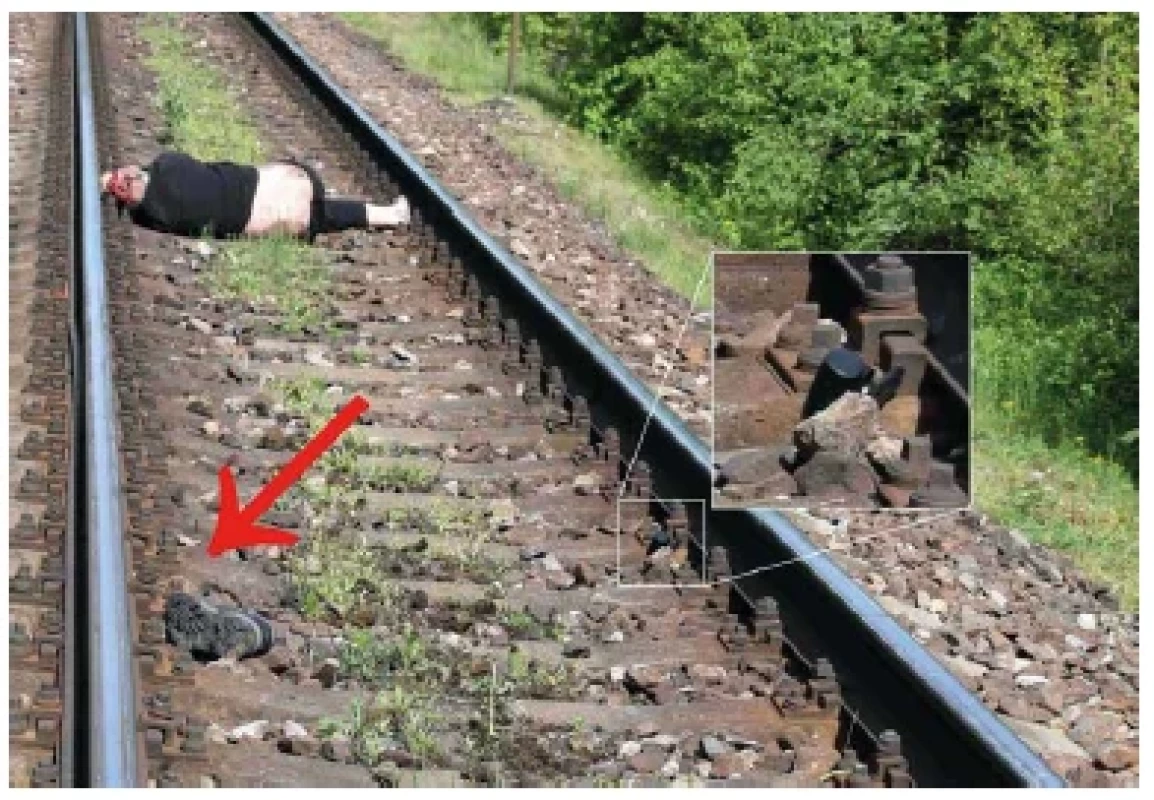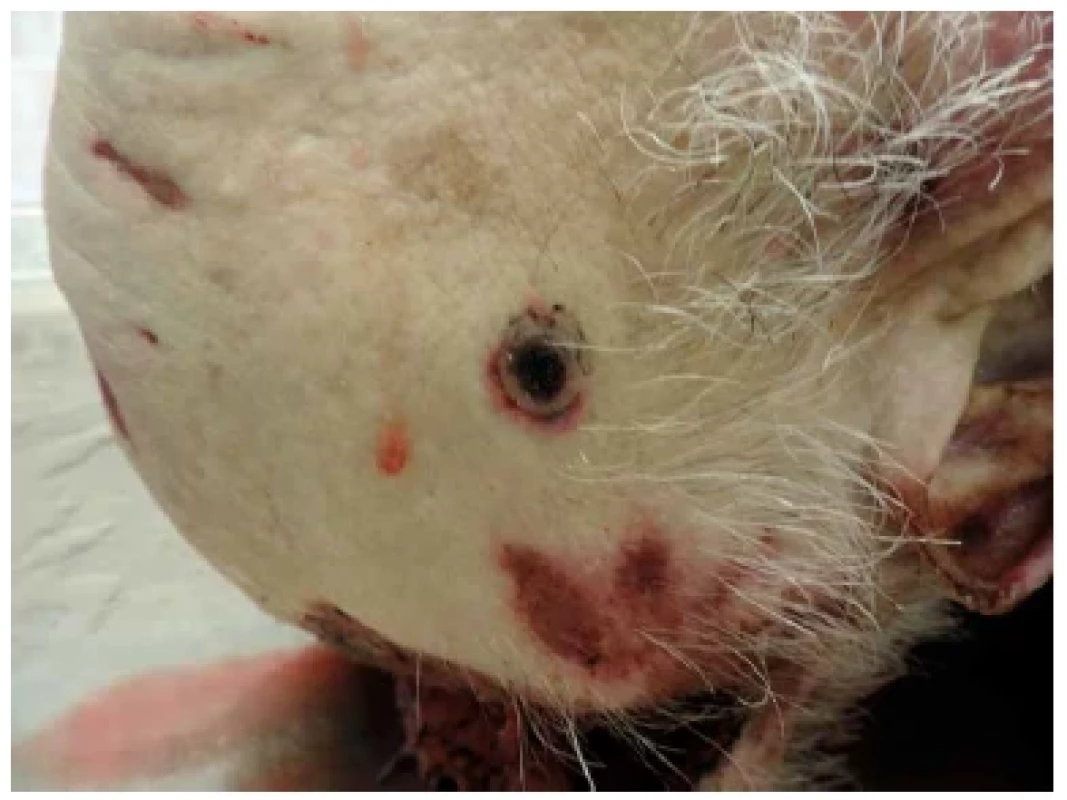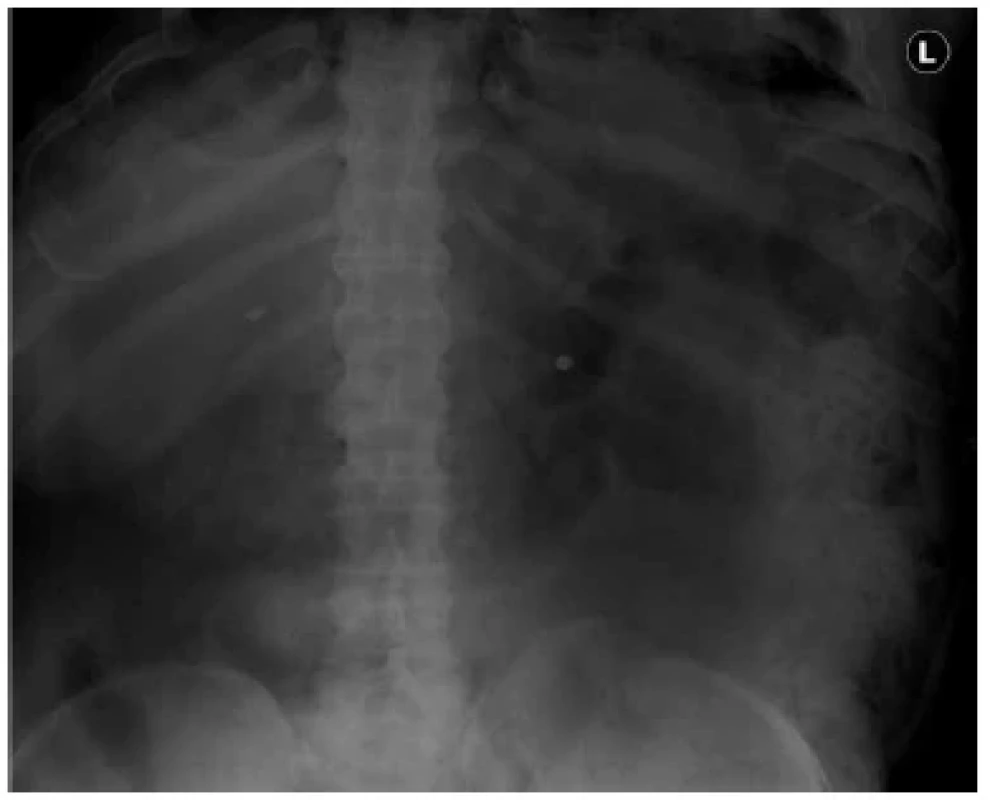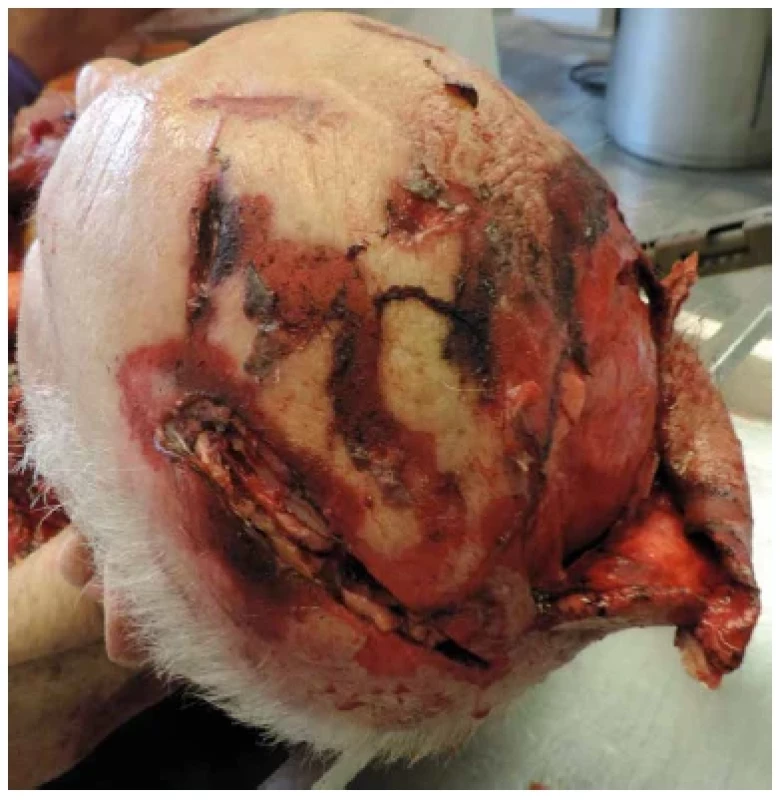An unplanned complex suicide with 6 mm Flobert revolver and train crash: a case report
Authors:
Richard Sivulič; Martin Janík; Veronika Rybárová; Ján Bajaj; Ubomír Straka
Published in:
Soud Lék., 68, 2023, No. 2, p. 15-18
Category:
Overview
A complex suicide defines a combination of multiple suicidal methods the victim successively or concurrently carries out. We present a case of a 72-year old man found dead on the railtrack, seemingly committing simple train-related suicide. Flobert revolver – a small caliber handgun was found nearby. Herein, we emphasize the significance of a thorough external examination, stress the fact that victim can act after low-energy projectile trauma and match our case to a similar complex suicide.
Keywords:
gunshot wounds – Flobert revolver – unplanned complex suicide – train crash
Complex suicides define a combination of suicidal methods employed consecutively or simultaneously to ensure death (1,2,4,7-9). In planned complex suicides, the methods are executed simultaneously with the purpose of minimising the risk of a failure or reducing the amount of pain caused (1-7,10). Unplanned complex suicide differs in a spontaneous choice of a different self-killing method, after the initial failed, was tormenting or took too long (1-4, 11-15).
This paper presents a phenomenon of using two knowingly lethal and somewhat uncommon suicidal techniques in combination, which appears not to have been a routine in medico-legal literature. The employment of Flobert´s revolver and low energy ammunition render the case noteworthy. The authors aspire to provide a detailed evaluation and their insight on this remarkable case and its circumstances.
CASE REPORT
A 72-year old man was found dead on the railtrack. Initially, the case resembled a simple suicide by a train crash. Soon after, Flobert´s revolver – a small caliber handgun was found at the scene and multiple gunshot wounds were identified on the decedent. The police requested further investigation where forensic autopsy was in order.
External examination revealed three gunshot wounds. The first was located at the right temple, 2.5 cm from the top margin of the right auricule, breaching the skin and subcutaneous tissues without damaging the cranium. The wound was 0.7 cm wide, constricted, with an imprint of the muzzle as a narrow circumferential abrasion collar. A circular zone of soot was encircling the entry wound (Fig. 2). The second gunshot wound was discovered intraorally as a stellate-shaped defect in the hard palate. The projectile then ricocheted into the oesophagus, was swallowed and found near the pylorus (Fig. 3). The third gunshot wound was located on the left side of the abdomen, 116 cm from the bottom of the left foot, 19 cm from the abdominal midline. The defect was surrounded by 7 cm wide bruising, was shallow, penetrating only into the subcutaneous fat, causing contusion and bleeding. Abdominal cavity was unharmed by the projectile.
Externally, the body showed apparent signs of polytrauma. The clothing of the victim was torn and stained by blood with black markings. The victim´s head was devastated by the blunt force, with an extensive laceration of the scalp 15x17 cm with serrated and contused margins on the right side of the head, under which the shattered skull and uncovered dura was visible. Another 15 cm long laceration with a linked fracture, exposing the brain tissue on the left side of the parietal region and a 4 cm long contused laceration on the upper left side of the forehead are present (Fig. 4). Part of the right foot of the victim was traumatically amputated. The cervical spine was fractured. The right part of the chest wall and back were deformed and numerous abrasions all over the torso and limbs were noticeable. After the review of the external injuries, the victim most likely assumed a squatting or kneeling position, with his back turned to the incoming train.
Internal examination proved cranial fractures, crushing wounds of the brain with severing of the brainstem in pons area, disconnection of the fibrous junction between the head and the neck, traumatic detachment of the spine from the cranial base, numerous fractures of the ribs and sternum and fractures of the thoracic spine and pelvis. Lungs were contused with multiple tears on the surface from the sharp ends of the broken ribs, right atrium of the heart was split by a 2 cm long laceration and aorta was torn. Blood was present in the thoracic cavity. From the organs of the abdominal cavity, only the spleen was ruptured. Ethanol and toxicological analyses showed negative results.
The preliminary cause of death was verified by the forensic autopsy – a severe devastating blunt force trauma of the brain with severing of the brainstem, fracture of the cervical spine and other injuries compatible with train collision. The train collision was preceded by multiple self-inflicted non-lethal gunshot wounds to various body areas. From the forensic standpoint, based on the circumstances of the victim´s death and findings from the autopsy, the matter was categorized as an unplanned complex suicide.
DISCUSSION
The worldwide suicide deaths amount to 700,000 per year (16). Complex suicides make up to 5% out of all completed suicides (2). The methods employed in complex suicides do not differ from simple suicides (9,25), where hanging, medication overdose, firearms, drowning and fall from height prevail (9). However, planned and unplanned suicides seem to vary in the amount and types of the methods used. The most frequent conjunction for planned complex suicides are ingestions of medicaments with hanging, drowning or suffocation and a combination of using firearms with hanging or drowning. Unplanned complex suicides mostly display the self-infliction of cut and stab wounds, followed by hanging or drowning (27). The number of methods employed dominates in unplanned complex suicides, often showing three or more, whereas the planned ones typically include two (11,27). Cases linking gunshots and vehicular crash (2), self-stabbing and vehicular crash (4), drug intoxication and catheterization (3), gunshot and self-immolation (14), bolt gunshot and hanging (13), self-poisoning and hanging, self-cutting, hanging and drug ingestion, self-cutting and acid ingestion are described (12). To our best knowledge, only a single study concerning a complex suicide by gunshot wounds and train crash has been published so far.
Gunshot wounds are the second most common suicidal method for males in Slovakia. They make up to 11,8 % of all men suicides (22), with a fatality rate of 83-91 % (18). Majority of the self-inflicted gunshot wounds are localised on the head, constituting 55-60 % of these injuries (23,24). More than half are located on the right temple and inside the mouth (25).
Considering the anatomical location of the gunshot wounds of the victim, it is safe to say that the deceased could cause these injuries to himself. Judging by the markings and the intravital reaction of the tissues, the gunshot wounds were inflicted point-blank while alive.
The handgun used, Flobert´s 6 mm revolver, fires low-energy projectiles, mostly 10 mm wide rubber balls. Energy of these rubber projectiles is barely sufficient to penetrate the human skin (19). However, the deceased used 6 mm Flobert bullet (.22 conical ball cap). This type of rimfire ammunition consists of a very small propellant charge (usually only a primer without gunpowder) and a 29 grain bullet (just under 2 g), exerting a low amount of energy on impact. The muzzle velocity of the projectile is about 215 m/s (20).
It is in the role of a forensic pathologist to determine the chronological succession of the injuries, as well as evaluating the ability to act after such trauma (27). The ability to act after a gunshot wound to the head may raise suspicion and indicate a possible homicide. The study by Arunkumal et al. revealed, that even several gunshot wounds to the head may not only fail to kill, but even not be enough to incapacitate the victim. Furthermore, the projectiles described in the study were of a larger energy than the ones of our victim (21).
Even though the skin and subcutaneous fat were damaged, no essential organs were harmed. Consequently, we can establish that the victim was fully conscious, capable of reasoning, and able to move freely. This turn of events lead to a distinct way of suiciding.
Railway suicides are a fairly infrequent, but very unfailing way of taking one’s own life. They amount to 1-12 % suicides internationally and display up to 94% fatality rate (17,28). Males prefer this type of suicide over females. Results show, that 60-83 % of the railway suicide victims suffered from a psychiatric disorder. 81 % of them had a history of hospitalization at the psychiatry ward (17). Unfortunately, due to the absence of anamnestic data, suicide note and history of the victim, we were unable to confirm this correlation.
An article from Schweitzer et al. documents a similar case of a complex suicide. In this case, the victim placed a wooden chair on the railtrack, sat on it and reportedly shot himself in the head as the train was closing in. The testimony of the train driver revealed the alleged collapse of the body, preceded by the handgun aimed at the victim´s head. The body was decapitated and severely mangled by the impact, reconstituted by the virtopsy (26).
In comparison, the other victim seemed to have lost consciousness upon the infliction of the gunshot wound and was hit by the train promptly after. Our victim stayed conscious after the shooting and ended his life by colliding with the train. The time between the shots and the impact is obscure. The place where the gunshots were inflicted is unknown. It is perplexing, whether the victim knew of the poor lethal potential of the firearms. The critical difference between the cases, is the failure of the first self-killing method deployed in our case, signifying the contrast between an unplanned and planned complex suicide.
CONCLUSION
In conclusion, the role of forensic pathologists is to determine the cause of death. In this case, the preliminary cause of death became questionable after the discovery of several gunshot wounds. Such vague initial findings can complicate the interpretation, making the investigation of such events harder than of planned complex suicides. Such incident highlights the importance of proper examination of the gunshot wounds, their morphology, location and linked effect, not only on the survival of the victim, but also on his following ability to act. Nevertheless, the data gathered at the scene and from the autopsy strongly supported an unplanned complex suicide.
CONFLICT OF INTEREST
The authors declare that there is no conflict of interest regarding the publication of this paper.
Correnspondence address:
prof. MUDr. Ľubomír Straka, PhD.
Department of Forensic Medicine and Medicolegal Expertises,
Jessenius Faculty of Medicine, Comenius University,
University Hospital, Martin, Slovak Republic
Kollárova 2, Martin 036 01
tel: +421 908 902 998
fax: +421 434 132 770
e-mail: janik.mato@gmail.com
Received: April 4, 2023
Accepted: April 14, 2023
Soud Lek 2023; 68(2): 15–18
Sources
1. Kučerová Š, Zátopková L, Vojtíšek T, Ublová M, Hejna P. An Unplanned Complex Suicide by Multiple Blank Cartridge Gunshots and Cutting. J Forensic Sci 2019; 64(2): 616-621.
2. Straka Ľ, Novomeský F, Štuller F, Janík M, Krajčovič J, Hejna P. A planned complex suicide by gunshot and vehicular crash. Forensic Sci Int 2013; 228: 50-53.
3. Pélissier-Alicot AL, Deveaux M, Sastre C, et al. Planned complex suicide involving combined drug intoxication and femoral catheterization. J Forensic Sci 2021; 66(6): 2527- 2531.
4. Christin E, Hiquet J, Fougas J, Dubourg O, Gromb-Monnoyeur S. A planned complex suicide by self-stabbing and vehicular crash: An original case and review of the literature. Forensic Sci Int 2018; 285: 13-16.
5. Germerott T, Jaenisch S, Hatch G, Albrecht UV, Guenther D. Planned complex suicide: Self-strangulation and plaster ingestion. Forensic Sci Int 2010; 202(1-3): 35-37.
6. Banchini A, Schirripa ML, Anzillotti L, Cecchi R. Planned and unplanned complex suicides: Casuistry of the Institute of Legal Medicine of Parma (Italy). Leg Med (Tokyo) 2017; 29: 62-67.
7. Nor FM, Das S. Planned complex suicide: self-strangulation and fall from height. J Forensic Leg Med 2011; 18(7): 336-339.
8. Töro K, Pollak S. Complex suicide versus complicated suicide. Forensic Sci Int 2009; 184(1-3): 6-9.
9. Pélissier-Alicot AL, Gavaudan G, Bartoli C et al. Planned complex suicide: an unusual case. J Forensic Sci 2008; 53(4): 968-970.
10. Nikolić S, Zivković V, Juković F. Planned complex occupation-related suicide by captive- bolt gunshot and hanging. J Forensic Sci 2011; 56(1): 248-251.
11. Racette S, Sauvageau A. Planned and unplanned complex suicides: a 5-year retrospective study. J Forensic Sci 2007; 52(2): 449-452.
12. Altun G. Planned complex suicide: report of three cases. Forensic Sci Int 2006; 157(2-3): 83- 86.
13. Viel G, Schröder AS, Püschel K, Braun C. Planned complex suicide by penetrating captive- bolt gunshot and hanging: case study and review of the literature. Forensic Sci Int 2009; 187(1-3): 7-11.
14. Türk EE, Anders S, Tsokos M. Planned complex suicide. Report of two autopsy cases of suicidal shot injury and subsequent self-immolation. Forensic Sci Int 2004; 139(1): 35-38.
15. Hejna P, Šafr M, Zátopková L, Straka Ľ. Complex suicide with black powder muzzle loading derringer. Forensic Sci Med Pathol 2012; 8(3): 296-300.
16. World health statistics 2022: monitoring health for the SDGs, sustainable development goals.
17. Krysinska K, De Leo D. Suicide on railway networks: epidemiology, risk factors and prevention. Aust N Z J Psychiatry 2008; 42(9): 763- 771.
18. Haw C, Sutton L, Simkin S et al. Suicide by gunshot in the United Kingdom: a review of the literature. Med Sci Law 2004; 44(4): 295- 310.
19. Frank M, Peters D, Klemm W et al. Penetrating chest trauma caused by a blank cartridge actuated rubber ball projectile: case presentation and ballistic investigation of an uncommon weapon type. Int J Legal Med 2017; 131(5): 1307-1312.
20. Barnes FC. Cartridges of the World 17th Edition, Gun Digest Books; 2022. ISBN 1-95111- 559-7
21. Arunkumar P, Maiese A, Bolino G, Gitto L. Determined to Die! Ability to Act Following Multiple Self-inflicted Gunshot Wounds to the Head. The Cook County Office of Medical Examiner Experience (2005-2012) and Review of Literature. J Forensic Sci 2015; 60(5): 1373- 1379.
22. Bražinová A, Moravanský N, Guliš G, Skodacek I. Suicide rate trends in the Slovak Republic in 1993–2015. Int J Soc Psychiatry 2017; 63(2): 161–168.
23. Sutton L, Hawton K, Simkin S et al. Gunshot suicides in England. Soc Psychiatry Psychiatr Epidemiol 2005; 40(4): 324–328.
24. Balci Y, Canogullari G, Ulupinar E. Characterization of the gunshot suicides. J Forensic Leg Med 2007; 14(4): 203–208.
25. Blumenthal R. Suicidal Gunshot Wounds to the Head. Am J Forensic Med Pathol 2007; 28(4): 288–291.
26. Wolf Schweitzer, Michael J. Thali, Garyfalia Ampanozi. Planned complex suicide combining pistol head shot and train suicide and Virtopsy examination. Forensic Imaging 2022; 28: 200485.
27. Bohnert M. Complex Suicides. Forensic Pathology Reviews 2005; 127–143.
28. Too LS, Milner A, Bugeja L, McClure R. The socio-environmental determinants of railway suicide: a systematic review. BMC Public Health 2014; 10: 14-20.
Labels
Anatomical pathology Forensic medical examiner ToxicologyArticle was published in
Forensic Medicine

2023 Issue 2
Most read in this issue
- Issues of electric shock in forensic medical practice
- An unplanned complex suicide with 6 mm Flobert revolver and train crash: a case report
- Alcohol and addictive substances in deceased active participants of traffic accidents
- Volodymyr Shylov – vystoupení k aktuální problematice válečných zločinů na Ukrajině.




